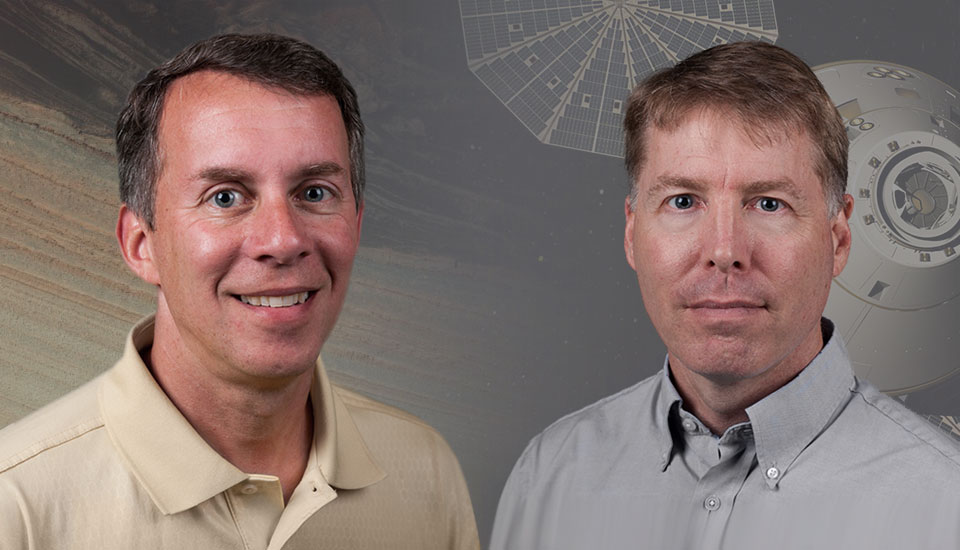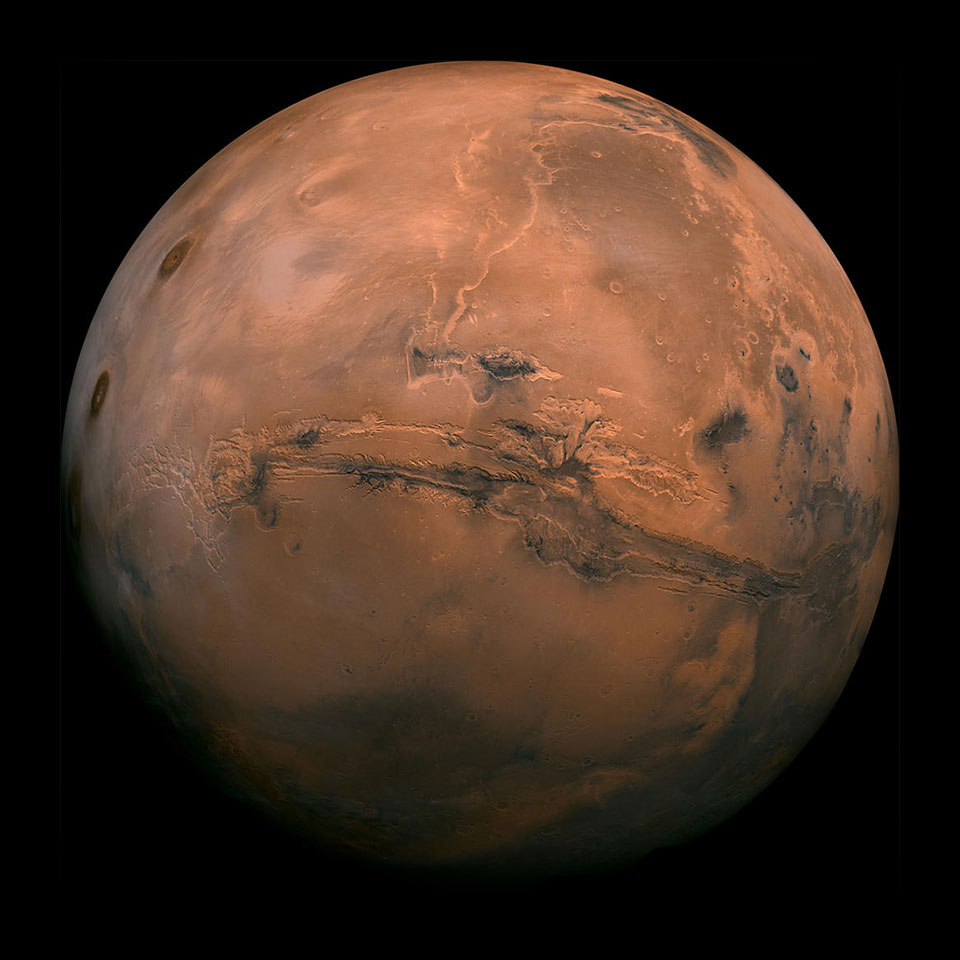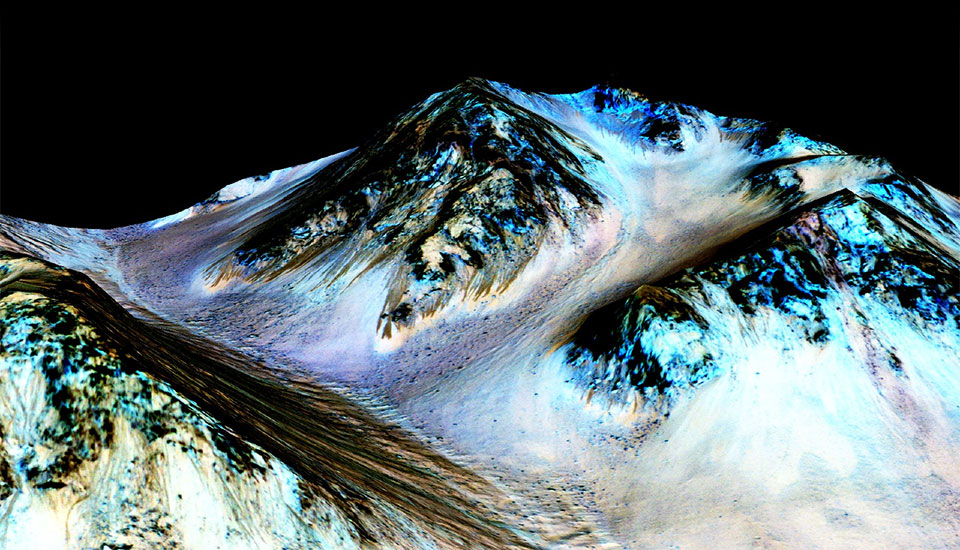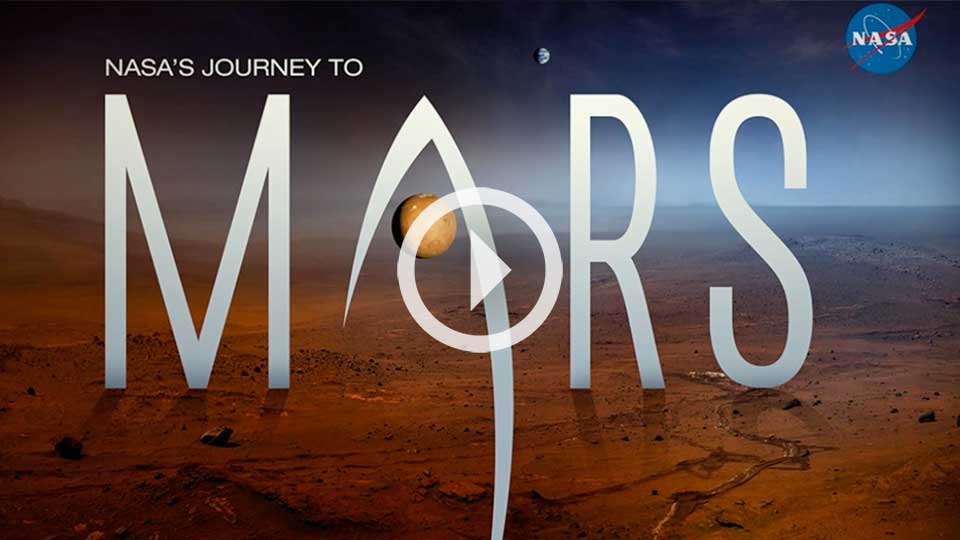
Humans on Mars
This is an important, exciting week for Mars and planetary scientists. NASA and the Jet Propulsion Lab held a press conference on Monday to unveil the findings of a Georgia Tech-led study about flowing water on present-day Mars.
Ph.D. candidates Lujendra Ojha and Mary Beth Wilhelm and their advisor, Assistant Professor James Wray, have found evidence of hydrated salts on the planet. Their findings indicate that water on Mars isn’t just ancient or frozen.
The announcement, which NASA billed as a “mystery solved,” kicked off a week that will end with the release of The Martian. The science fiction thriller stars Matt Damon. He’s an American astronaut abandoned by his crew, stranded alone on the Red Planet and desperately trying to find a way to signal to Earth that he’s still alive. The movie is based on a 2011 best-selling book of the same title.
Georgia Tech’s researchers are working to make sure humans on Mars aren’t something reserved only for Hollywood. Faculty members are creating the next technologies for future missions, landing locations, and instruments to find life. Their expertise and insight will help guide us all to the next frontier.
The Why, When, and How of a Manned Mission to Mars

U.S. News & World Report ranks the undergraduate program in Georgia’s Tech’s Daniel Guggenheim School of Aerospace Engineering No. 2 in the nation. Two of its leaders, Professors Bobby Braun and Dave Spencer, have a long history with Mars.
Braun was a member of the Mars Pathfinder entry, descent, and landing team in 1997 and has been a part of every Mars landed mission since. He’s now the chair of the standing review board for the Mars 2020 Project, NASA’s next large rover mission.
Spencer was also on the Pathfinder team as mission designer while working at the Jet Propulsion Lab in California. He went on to serve as the Mars Odyssey mission manager (2001) and was the deputy project manager for the Phoenix Mars lander (2008). He joined Georgia Tech after leading Phoenix surface operations.
Braun and Spencer sat down to discuss and debate when humans will get to Mars, the cost of this unprecedented mission, and the technical challenges of making the historic journey.
Why should humans go to Mars?
Spencer: Exploration is in our DNA. It’s what we as a people, and the United States in particular, are built upon. Mars is the next logical step and the direction our species is headed toward.
Braun: NASA was built on big goals and dreams. Achieving large goals is precisely what the nation expects from its space program. A great way to build U.S. scientific and technological competence is by aiming large.
Why can’t we go there now?
Braun: We could choose to start sending humans to Mars in the next decade if we put our minds to it. The pace of our journey is driven by the pace of our investment in the technologies and capabilities needed for exploration.
Spencer: There’s a fundamental difference between the way the Apollo missions were undertaken versus the current way the Mars exploration program is conceived. Apollo had a very clear set of goals to launch humans into space within a decade. Now, the mindset is that we’re operating under a fixed budget, we must live within it, and only build as we can. That’s a very slow process.
Braun: In the Apollo days, the NASA budget was 10 times what it is today. It was roughly 4 percent of the gross domestic product. Now it’s about .4 percent. Imagine if revenues for a university or a computer company were one-tenth what they were 50 years ago.
Why is it so different?
Braun: Apollo wasn’t really about sending people to the moon within a decade.
It was about proving the technological superiority of the United States in a race with the
Soviet Union. That’s why funding poured into NASA. It’s a different world now. People who are
waiting for the next Kennedy moment are going to wait a long time. I think we’re going to have
to figure this out within the general federal funding guidelines that have been in place since
the Nixon administration: NASA has to take its rightful place in the federal budget among the
other priorities the United States invests in.
Spencer: So that means an international collaboration is essential for
something as complex and expensive as going to Mars.
Braun: Yes. And more significant partnerships with the U.S. commercial space sector.
What are some of the biggest technological challenges?
Spencer: A round trip is a minimum of two years: at least six months to get there, one year on Mars, and about six months to get back. The radiation exposure an astronaut would get during that time period is a large fraction of what’s considered to be a safe level of radiation dosage for a lifetime. Radiation shielding is needed, but that adds mass. And mass is one of the key costs of going into space.
Braun: And then there’s landing very large payloads. The Curiosity rover is the largest thing we’ve ever put on Mars, and it’s the size of a small car. For humans, we’re talking about landing a series of two-story houses to establish a base camp. We also need to improve the efficiency of our propulsion systems for the flight to Mars and learn to make use of the surface resources available once there.

Mosaic of the Valles Marineris hemisphere of Mars projected into point perspective, a view similar to what one would see from a spacecraft. Image credit: NASA/JPL-Caltech
Would people come back from the first mission?
Braun: I hope so. There are groups that want to do pure settlement: a one-way trip. But I don’t think the U.S. and the world would make the investment if it were a one-way trip. I think the reason you send people to Mars is to bring them back so they can be heroes and inspire billions of others — like the Apollo astronauts. I would want to meet them. Wouldn’t you?
Spencer: It’s in our culture that the initial explorers go and come back. Think about Lewis and Clark, who returned to civilization after exploring the western part of the continent. Eventually, and not much later, people went out and settled the American West in large numbers.
Braun: Personally, I think there will be a handful of round-trip missions before we start settling.
When will people land on Mars?
Spencer: No earlier than 2040 and no later than 2100.
Braun: Eight years after we decide to do it. In other words, eight years after we have made considerable investments in proving the capabilities needed. We need a few capabilities for this mission: a big rocket, radiation shielding.
Spencer: An ascent vehicle.
Braun: Right. There are about six capabilities needed for a human Mars mission. Right now we’re probably investing in three of them, and at a very low level. I’ll know we are serious about sending people to Mars when I see this country and others invest in the needed capabilities in a significant way. Once we do, we’ll land eight years later.
Spencer: You’re more optimistic than I am.
How much money will it take?
Braun: A lot for the space program, but not very much for the world.
Spencer: At least $100 billion spread over 10 years. That’s not that much. You can spend a billion dollars easily on a relatively common infrastructure project. What does a football stadium cost? $1 billion?
Braun: Roughly $10-$15 billion a year for a decade. Right now NASA’s yearly budget is about $18 billion, and we spend about half of that on human spaceflight. If the rest of the world (Russia, China, Europe) matched the U.S. investment, Mars would be within our grasp.
Final question: What does Martian exploration look like 100-150 years from now?
Spencer: It will be like Antarctica is today: People will be ferried to the surface to do research for a certain time period and then return. There will be crops on Mars. But it will be a small footprint – it’s tough to live up there. But we will.
Braun: One hundred years from now, our space program will be even more significant and more ubiquitous to life on Earth. We’ll have journeyed to the ocean worlds in the outer solar system, where many believe there may be life waiting to be discovered. We’ll have learned about other earths around distant stars. We’ll have imaged them and seen blue oceans and white clouds. In 100-150 years, we will have settled Mars at some level, as well as answered other fundamental societal questions such as: Are we alone and where did we come from?
How do you find life on Mars?

Amanda Stockton is an assistant professor in the School of Chemistry and Biochemistry. Her research focuses on the origin of biomolecules and the emergence of life on Mars and throughout the galaxy. She doesn’t just cook up chemical reactions in her lab — she builds instruments she hopes will fly someday to Mars and search for the basic building blocks of life, whatever it may happen to look like 140 million miles from home.
How do you find life on Mars when it’s completely different from life in a totally different chemical and thermodynamic environment? There’s no reason to think that it’s anything like what we have here. We can’t assume it’s chosen the same building blocks as what makes up our proteins or DNA.
Here’s another way of thinking about it: There are 20 amino acids on Earth. They build the enzymes that create the fingerprint of terrestrial life. There are more than 100 amino acids found in meteorites. The fingerprint, if you even want to call it that, is completely different. You can’t assume Martian life would have the exact same 20-amino-acid fingerprint as Earth.

Amanda Stockton holds a programmable microfluidic device that enables
automated sample processing and analysis of amino acids. Photo: Fitrah Hamid
But here’s the bigger issue — we have to quit sending the same instruments up there. We’ve never sent or used an instrument on Mars that can directly detect amino acids. We’re doing the chemistry wrong. Instead of heating samples and watching for organics to evaporate into a gas analyzer, we need a wet-extraction method that sends samples to a liquid analyzer. We need a fancy Martian espresso maker — something that can dig into the soil, put it into a liquid and a tool that can analyze the Martian espresso directly. That’s when we’ll truly know what’s in the dirt.
I think there’s life on Mars. We can get really far with analytical instruments, but to absolutely confirm it, you have to eventually send people. Robots and rovers can’t think for themselves and recognize those patterns indicative of life, like faces and fingerprints. Humans can. But that brings up a different issue: People are living, breathing bags of bacteria capable of contaminating the planet. So when humans get there, we’ll start searching and could very likely find only what we brought with us.
Humans on Mars prediction:
We have all the science and engineering in place to go right now. We just need to do it. All we’re lacking is the funding and the political will. I really don’t want us to go and contaminate the planet until an unmanned mission is able to return a definitive answer about life up there. Without that, we’ll never know what’s native and what came along with us. So I’m thinking somewhere between 2040 and 2050.
The Ideal Landing Spot
Where on the surface would we land?

“When” is the billion dollar mystery regarding humans and Mars. But James Wray, an assistant professor in the School of Earth and Atmospheric Sciences, is more concerned with “where,” as in, where people will land on Mars. Next month he’ll attend a workshop in Houston to begin discussions about potential landing sites for a piloted mission. Wray says the answer is pretty simple: Follow the water.
Mars is typically a lot colder than humans — and the foods we eat — prefer for optimal growth and comfort, so one of the first things we should look for is a relatively warm site. Similar to Earth, Mars is tilted 25 degrees relative to its orbit around the Sun, which gives it Earth-like seasons. But Mars also changes its distance from the Sun much more than our planet, exaggerating its seasonal variations. For example, in the Southern Hemisphere, the highest temperatures are short-lived and launch a string of dust storms every summer. These are later followed by a long, very cold winter. Astronauts would do better to stay near the equator, where temperatures remain among the highest Mars can offer year-round.
As fans of The Martian have learned, water can quickly become the limiting factor for sustaining life on a desert planet. There’s plenty of frozen water at the Martian poles, and even at temperate latitudes if you are willing to dig for it, as NASA’s Phoenix lander did. But in the warmer tropics, ice is unstable anywhere near the surface. This is why “recurring slope lineae” (RSL), narrow dark streaks that flow down warm Martian slopes in the summertime, have excited both scientists and technologists: they may represent some of the few locations where water is available near the equator today. We don’t yet know if this water comes from underground aquifers, melting ice, or salts that draw vapor out of Mars’ thin atmosphere. But if it’s there for the taking, then it could be a valuable resource for future explorers.

Enhanced image from a Georgia
Tech-led study about flowing water on present-day Mars by Ph.D. candidates Lujendra Ojha
and Mary Beth Wilhelm, and their advisor, Assistant Professor James Wray, showing evidence of
hydrated salts on the planet. Image credit: NASA/JPL/University of Arizona
Some water on Mars is stored in minerals, such as hydrated salts and clays. These may also be useful resources. Scientifically, they represent some of the most promising materials in which to search for evidence of indigenous life. Spectacular and diverse geology should be a prime driver for landing-site selection for both its scientific and inspirational potential, just as Arizona’s Grand Canyon is simultaneously a “Rosetta stone” for geologists and a stirring sight for visitors of any background. Mars has a far grander set of canyons near its equator, which host both a wide range of hydrated minerals and the densest concentration of RSL on the planet.
Humans on Mars prediction:
All I know for sure is that I'd like to be around to watch. I’m eager to do anything I can as a scientist to help us toward that end. And if it happens when I'm still young and healthy enough to make the journey myself, I will be interested. That probably sets an effective deadline of around 2040. I see no reason to wait longer! As children, we were promised that humans would someday explore the surface of Mars. Technologically and socially, motivated people carry us further into the future every day. We have electric sports cars, TV from space, and all the world's knowledge in our pockets.
Martian Politics
Will it be a worldwide effort?

Mariel Borowitz is an assistant professor in the Sam Nunn School of International Affairs who studies space and technology policy. While plenty of technical challenges will have to be overcome before humans are sent to Mars, Borowitz says they are just as difficult as the politics.
Carrying out a human mission to Mars will require more than a decade of planning and preparing. To have any hope of keeping to NASA’s timeline of “sometime in the 2030s,” Congress must provide adequate funding every year from now until then, regardless of changing political priorities, partisan battles, and — perhaps most challenging — the fact that they may no longer be in office by the time constituents see the payoff from this investment.
A successful mission to Mars also requires continuity and support across multiple presidential
administrations. However, there is a great temptation for each new president to put his or her
own personal stamp on the space mission. In fact, three different “missions to Mars” have been
announced since the 1980s. Most recently, President Barack Obama canceled President George W.
Bush’s plan, replacing it with a scaled back, “flexible path” approach to human exploration
(which NASA now calls the “Journey
to Mars”).
VIDEO: 50 Years of Mars Exploration from NASA Jet
Propulsion Laboratory
2015 marks 50 years of successful NASA missions to Mars starting with Mariner 4 in 1965. The
journey to Mars continues with additional robotic missions planned for 2016 and 2020, and human
missions in the 2030s.
But national politics aren’t the only issue. International cooperation is essential for such an expensive and complicated mission. The good news is that almost every major spacefaring nation agrees that putting humans on Mars is the long-term goal. The bad news is that they disagree on the intermediate missions that can and should be undertaken between now and then. For example, NASA wants to place an asteroid in orbit around the Moon for human study, but there’s very little international interest. Both Russia and China — the only nations other than the U.S. that currently have the capability to send humans into space — have announced plans to go to the Moon.
Of course, there’s always the private sector. SpaceX, Inspiration Mars, and Mars One have all announced plans to send humans to Mars — some much sooner than any government plans. Unfortunately, technical and funding issues apply to them as well. Mars One, which plans to send people on a one-way mission as soon as 2026 to start a permanent colony, seems both technically and financially unlikely to succeed on their current schedule. Inspiration Mars wants NASA to provide the rocket for free — something NASA has not expressed any interest in doing. SpaceX is building its own rocket, targeting a piloted mission by the 2020s, but the company is a launch hiatus after a failure earlier this year.
These political challenges can be overcome. NASA, and human exploration in general, has long had strong, bipartisan support. Despite debates about the intermediate missions, domestic and international leaders agree that the ultimate goal is to put humans on Mars, and NASA is currently building the most powerful rocket in history — the Space Launch System. Now the United States needs to engage with its international partners to agree on a long-term plan to keep development on track.
Humans on Mars prediction:
NASA is currently projecting that humans will land in the 2030s. Since nothing ever seems to go exactly according to plan, I'd expect something more like 2040. Some potential wild cards could speed things up: commercial entities make significant progress and push the government to go faster and/or China starts focusing on Mars (through competition or cooperation).
Can science fiction become reality?

Lisa Yaszek is a professor in the School of Literature, Media, and Communication who assigns the book The Martian in her history of science fiction class. She says that Mars sci-fi has shifted back and forth dramatically for more than a century, largely in relation to technology.
When Andy Weir finished writing The Martian in 2011, publishers paid no attention. So he published it himself, posting one chapter at a time on his website. People started to notice and urged him to put the entire book on Amazon. It sold 35,000 copies in three months (at 99 cents). In 2013, a publisher bought the rights and The Martian debuted on The New York Times best-seller list the next year.
Science fiction writers have dreamed of Mars’ potential since the late 1800s when telescopes improved and started to become affordable for more people. The images weren’t very good, so people interpreted what they thought they saw on Mars in terms of what they knew to be true about Earth — the white substance on the poles must be frozen water and the canals on the surface probably once held liquid water. People knew the Moon was uninhabitable. But seeing this new world led to a boom of Martian storytelling about life. Many authors wrote about a Martian species fighting its own extinction by invading someplace more promising: Earth. H.G. Wells wrote the legendary War of the Worlds based on these themes in 1897. Authors also told wildly romantic stories about Mars, which looked like the new American West — a whole new frontier. Books like Edgar Rice Burroughs’ John Carter of Mars series chronicled humans escaping Earth for a new start on a new planet.

Vintage Startling Stories pulp magazine from Lisa Yaszek's collection. Photo: Fitrah Hamid.
Better visuals in the 1940s and ’50s revealed that the planet wasn’t a drying-out Garden of Eden. Colonization would be very difficult, but we were going to do it anyway. That’s when the real settlement stories began, complete with the dangers of doing so: deaths during construction accidents or people left behind on expeditions. We saw a whole raft of stories in the 1950s that are called Robinsonade, or based on Robinson Crusoe. Arthur C. Clark’s The Sands of Mars is a good example.
Science fiction authors stopped writing about Mars in the 1960s and ’70s when probes revealed it might be impossible to ever live there.
But in the 1990s, optimism returned after President George H. W. Bush announced a plan to put Americans on Mars in the 21st century. His idea eventually fizzled, but it sparked a science fiction renewal. A wealth of new books and movies about colonization were released as NASA landed rovers on the planet. Director Paul Verhoeven’s Total Recall and author Kim Stanley Robinson’s The Mars Trilogy are a few examples. That excitement continues today in current science fiction.
The Martian is classic science fiction. It’s true to the optimism of science and technology with opportunities to map and explore the universe. It’s the Mars version of Robinson Crusoe. Weir tells a story of an astronaut left behind, trying to find a way home. It’s truly a throwback to the older classics in the 1950s. At the same time, it updates classic science fiction by addressing the very real difficulties of exploring Mars in a contemporary, global context.

A selection of vintage science fiction books from Lisa Yaszek's library. Photo: Fitrah Hamid.
Humans on Mars prediction:
We’ve already been there. Science fiction has taken us to Mars since the 1800s through books, films, and comics. When humans actually arrive, I wonder what it will feel like. Will it be anything like what I’ve read about my entire life?








